5.4: Molar Mass- Mole-to-Mass and Mass-to-Mole Conversions
- Page ID
- 152164
- Perform conversions between mass and moles of a substance.
- Convert from mass or moles of one substance to mass or moles of another substance in a chemical reaction.
- Use a balanced chemical equation to determine molar relationships between substances.
Molar Mass
The molar mass of any substance is the mass in grams of one mole of representative particles of that substance. The representative particles can be atoms, molecules, or formula units of ionic compounds. This relationship is frequently used in the laboratory. The simplest type of manipulation using molar mass as a conversion factor is a mole-mass conversion (or its reverse, a mass-mole conversion). In such a conversion, we use the molar mass of a substance as a conversion factor to convert mole units into mass units (or, conversely, mass units into mole units).
We also established that 1 mol of Al has a mass of 26.98 g (Example). Stated mathematically,
1 mol Al = 26.98 g Al
We can divide both sides of this expression by either side to get one of two possible conversion factors:
\[\mathrm{\dfrac{1\: mol\: Al}{26.98\: g\: Al}\, and\, \dfrac{26.98\: g\: Al}{1\: mol\: Al}} \label{Eq1} \]
The first conversion factor can be used to convert from mass to moles, and the second converts from moles to mass. Both can be used to solve problems that would be hard to do “by eye.”
What is the mass of 3.987 mol of Al?
Solution
| Steps for Problem Solving | Example |
|---|---|
| Identify the "given"information and what the problem is asking you to "find." | Given: 3.987 mol of Al Find: g Al |
| List other known quantities | 1 mol Al = 26.98 g Al |
| Prepare a concept map and use the proper conversion factor. | 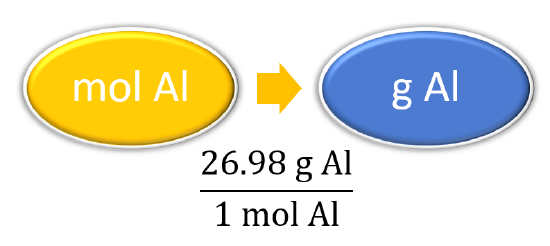 |
| Cancel units and calculate. | \(3.987 \: \cancel{\text{mol} \: \ce{Al}} \times \dfrac{26.98 \: \text{g} \: \ce{Al}}{1 \: \cancel{\text{mol} \: \ce{Al}}} = 107.6 \: \text{g} \: \ce{Al}\) |
| Think about your result. | The calculated value makes sense because it is almost four times times the mass for 1 mole of aluminum. Our final answer is expressed to four significant figures. |
How many moles are present in 100. g of Al? (Hint: you will have to use the other conversion factor we obtained for aluminum.)
Answer
3.71 g Al
Conversions like this are possible for any substance, as long as the proper atomic mass, formula mass, or molar mass is known (or can be determined) and expressed in grams per mole. Figure \(\PageIndex{1}\) is a chart for determining what conversion factor is needed, and Figure \(\PageIndex{2}\) is a flow diagram for the steps needed to perform a conversion.
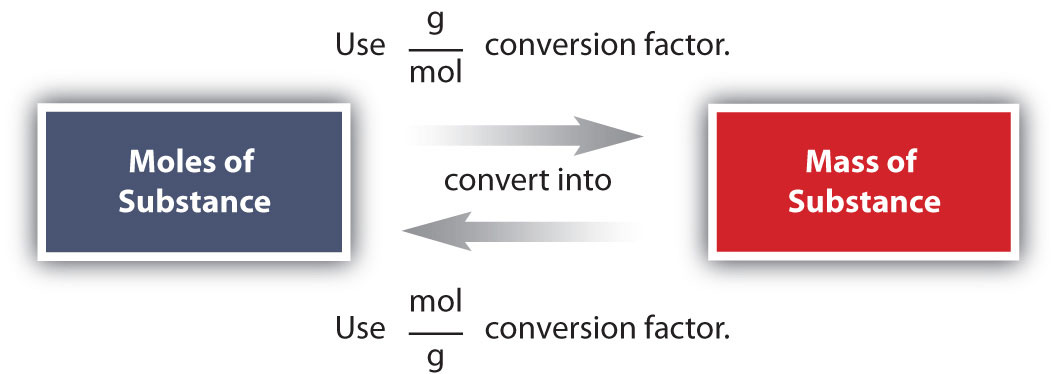

Suppose that for a certain experiment you need 3.00 moles of calcium chloride \(\left( \ce{CaCl_2} \right)\). Since calcium chloride is a solid, it would be convenient to use a balance to measure the mass that is needed. Dimensional analysis will allow you to calculate the mass of \(\ce{CaCl_2}\) that you should measure as show in Example \(\PageIndex{3}\).
Calculate the mass of 3.00 moles of calcium chloride (CaCl2).
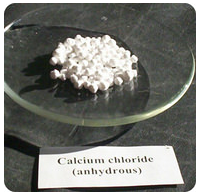
Solution
| Steps for Problem Solving | Example |
|---|---|
| Identify the "given"information and what the problem is asking you to "find." | Given: 3.00 moles of CaCl2 Find: g CaCl2 |
| List other known quantities | 1 ml CaCl2 = 110.98 g CaCl2 |
| Prepare a concept map and use the proper conversion factor. | |
| Cancel units and calculate. | \(3.00 \: \cancel{\text{mol} \: \ce{CaCl_2}} \times \dfrac{110.98 \: \text{g} \: \ce{CaCl_2}}{1 \: \cancel{\text{mol} \: \ce{CaCl_2}}} = 333 \: \text{g} \: \ce{CaCl_2}\) |
| Think about your result. |
What is the mass of \(7.50 \: \text{mol}\) of (calcium oxide) \(\ce{CaO}\)?
- Answer:
- 420.60 g
How many moles are present in 108 grams of water?
Solution
| Steps for Problem Solving | Example |
|---|---|
| Identify the "given"information and what the problem is asking you to "find." | Given: 108 g H2O Find: mol H2O |
| List other known quantities | \(1 \: \text{mol} \: \ce{H_2O} = 18.02 \: \text{g}\) H2O |
| Prepare a concept map and use the proper conversion factor. | |
| Cancel units and calculate. | \(108 \: \cancel{\text{g} \: \ce{H_2O}} \times \dfrac{1 \: \text{mol} \: \ce{H_2O}}{18.02 \: \cancel{\text{g} \: \ce{H_2O}}} = 5.99 \: \text{mol} \: \ce{H_2O}\) |
| Think about your result. |
What is the mass of \(7.50 \: \text{mol}\) of Nitrogen gas \(\ce{N2}\)?
- Answer:
- 210 g
Mole and Mass Relationships in Chemical Equations
We have established that a balanced chemical equation is balanced in terms of moles as well as atoms or molecules. We have used balanced equations to set up ratios, now in terms of moles of materials, that we can use as conversion factors to answer stoichiometric questions, such as how many moles of substance A react with so many moles of reactant B. We can extend this technique even further. Recall that we can relate a molar amount to a mass amount using molar mass. We can use that ability to answer stoichiometry questions in terms of the masses of a particular substance, in addition to moles. We do this using the following sequence:

Collectively, these conversions are called mole-mass calculations.
As an example, consider the balanced chemical equation
\[Fe_2O_3 + 3SO_3 \rightarrow Fe_2(SO_4)_3 \nonumber \]
If we have 3.59 mol of Fe2O3, how many grams of SO3 can react with it? Using the mole-mass calculation sequence, we can determine the required mass of SO3 in two steps. First, we construct the appropriate molar ratio, determined from the balanced chemical equation, to calculate the number of moles of SO3 needed. Then using the molar mass of SO3 as a conversion factor, we determine the mass that this number of moles of SO3 has.
As usual, we start with the quantity we were given:
\[\mathrm{3.59\: \cancel{ mol\: Fe_2O_3 } \times \left( \dfrac{3\: mol\: SO_3}{1\: \cancel{ mol\: Fe_2O_3}} \right) =10.77\: mol\: SO_3} \label{Eq2} \]
The mol Fe2O3 units cancel, leaving mol SO3 unit. Now, we take this answer and convert it to grams of SO3, using the molar mass of SO3 as the conversion factor:
\[\mathrm{10.77\: \bcancel{mol\: SO_3} \times \left( \dfrac{80.06\: g\: SO_3}{1\: \bcancel{ mol\: SO_3}} \right) =862\: g\: SO_3} \label{Eq3} \]
Our final answer is expressed to three significant figures. Thus, in a two-step process, we find that 862 g of SO3 will react with 3.59 mol of Fe2O3. Many problems of this type can be answered in this manner.
The same two-step problem can also be worked out in a single line, rather than as two separate steps, as follows:
\[ 3.59 \cancel{\, mol \, Fe_2O_3} \times \underbrace{\left( \dfrac{ 3 \bcancel{ \, mol\, SO_3}}{ 1 \cancel{\, mol\, Fe_2O_3}} \right)}_{\text{converts to moles of SO}_3} \times \underbrace{ \left( \dfrac{ 80.06 {\, g \, SO_3}}{ 1 \, \bcancel{ mol\, SO_3}} \right)}_{\text{converts to grams of SO}_3} = 862\, g\, SO_3 \nonumber \]
We get exactly the same answer when combining all the math steps together as we do when we calculate one step at a time.
How many moles of HCl will be produced when 249 g of AlCl3 are reacted according to this chemical equation?
\[2AlCl_3 + 3H_2O(ℓ) → Al_2O_3 + 6HCl(g) \nonumber \]
Solution
| Steps for Problem Solving | Example |
|---|---|
| Identify the "given"information and what the problem is asking you to "find." | Given: 249 g AlCl3 Find: moles HCl |
| List other known quantities | 1 mol AlCl3 = 133.33 g/mol 6 mol of HCl to 2 mol AlCl3 |
| Prepare a concept map and use the proper conversion factor. | |
| Cancel units and calculate. | \(249\, \cancel{g\, AlCl_{3}}\times \dfrac{1\, \cancel{mol\, AlCl_{3}}}{133.33\, \cancel{g\, AlCl_{3}}}\times \dfrac{6\, mol\, HCl}{2\, \cancel{mol\, AlCl_{3}}}=5.60\, mol\, HCl\) |
| Think about your result. | Since 249 g of AlCl3 is less than 266.66 g, the mass for 2 moles of AlCl3 and the relationship is 6 mol of HCl to 2 mol AlCl3 , the answer should be less than 6 moles of HCl. |
How many moles of Al2O3 will be produced when 23.9 g of H2O are reacted according to this chemical equation?
\[2AlCl_3 + 3H_2O(ℓ) → Al_2O_3 + 6HCl(g) \nonumber \]
- Answer
- 0.442 mol Al2O3
Molar Relationships in Chemical Equations
Previously, you learned to balance chemical equations by comparing the numbers of each type of atom in the reactants and products. The coefficients in front of the chemical formulas represent the numbers of molecules or formula units (depending on the type of substance). Here, we will extend the meaning of the coefficients in a chemical equation.
Consider the simple chemical equation
\[2H_2 + O_2 → 2H_2O \nonumber \]
The convention for writing balanced chemical equations is to use the lowest whole-number ratio for the coefficients. However, the equation is balanced as long as the coefficients are in a 2:1:2 ratio. For example, this equation is also balanced if we write it as
\[4H_2 + 2O_2 → 4H_2O \nonumber \]
The ratio of the coefficients is 4:2:4, which reduces to 2:1:2. The equation is also balanced if we were to write it as
\[22H_2 + 11O_2 → 22H_2O \nonumber \]
because 22:11:22 also reduces to 2:1:2.
Suppose we want to use larger numbers. Consider the following coefficients:
\[12.044 \times 10^{23}\; H_2 + 6.022 \times 10^{23}\; O_2 → 12.044 \times 10^{23}\; H_2O \nonumber \]
These coefficients also have the ratio 2:1:2 (check it and see), so this equation is balanced. But 6.022 × 1023 is 1 mol, while 12.044 × 1023 is 2 mol (and the number is written that way to make this more obvious), so we can simplify this version of the equation by writing it as
\[2 \;mol\; H_2 + 1\; mol\; O_2 → 2 \;mol\; H_2O \nonumber \]
We can leave out the word mol and not write the 1 coefficient (as is our habit), so the final form of the equation, still balanced, is
\[2H_2 + O_2 → 2H_2O \nonumber \]
Now we interpret the coefficients as referring to molar amounts, not individual molecules. The lesson? Balanced chemical equations are balanced not only at the molecular level but also in terms of molar amounts of reactants and products. Thus, we can read this reaction as “two moles of hydrogen react with one mole of oxygen to produce two moles of water.”
By the same token, the ratios we constructed to describe molecules reaction can also be constructed in terms of moles rather than molecules. For the reaction in which hydrogen and oxygen combine to make water, for example, we can construct the following ratios:
\[\mathrm{\dfrac{2\: mol\: H_2}{1\: mol\: O_2}\: or\: \dfrac{1\: mol\: O_2}{2\: mol\: H_2}} \nonumber \]
\[\mathrm{\dfrac{2\: mol\: H_2O}{1\: mol\: O_2}\: or\: \dfrac{1\: mol\: O_2}{2\: mol\: H_2O}} \nonumber \]
\[\mathrm{\dfrac{2\: mol\: H_2}{2\: mol\: H_2O}\: or\: \dfrac{2\: mol\: H_2O}{2\: mol\: H_2}} \nonumber \]
We can use these ratios to determine what amount of a substance, in moles, will react with or produce a given number of moles of a different substance. The study of the numerical relationships between the reactants and the products in balanced chemical reactions is called stoichiometry.
How many moles of oxygen react with hydrogen to produce 27.6 mol of H2O?
Solution
| Steps for Problem Solving | Example |
|---|---|
| Find a balanced equation that describes the reaction |
Unbalanced: H2 + O2 → H2O Balanced: 2H2 + O2 → 2H2O |
| Identify the "given"information and what the problem is asking you to "find." | Given: moles H2O Find: moles oxygen |
| List other known quantities | 1 mol O2 = 2 mol H2O |
| Prepare a concept map and use the proper conversion factor. | 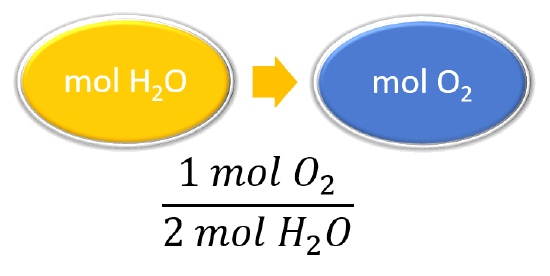 |
| Cancel units and calculate. |
\(\mathrm{\cancel{27.6\: mol\: H_2O}\times\dfrac{1\: mol\: O_2}{\cancel{2\: mol\: H_2O}}=13.8\: mol\: O_2}\) To produce 27.6 mol of H2O, 13.8 mol of O2 react. |
| Think about your result. | Since each mole of oxygen produces twice as many moles of water, it makes sense that the produced amount is greater than the reactant amount |
How many moles of ammonia are produced if 4.20 moles of hydrogen are reacted with an excess of nitrogen?
Solution
| Steps for Problem Solving | Example |
|---|---|
| Find a balanced equation that describes the reaction |
Unbalanced: N2 + H2 → NH3 Balanced: N2 + 3H2 → 2NH3 |
| Identify the "given"information and what the problem is asking you to "find." |
Given: \(\ce{H_2} = 4.20 \: \text{mol}\) Find: \(\text{mol}\) of \(\ce{NH_3}\) |
| List other known quantities | 3 mol H2 = 2 mol NH3 |
| Prepare a concept map and use the proper conversion factor. | 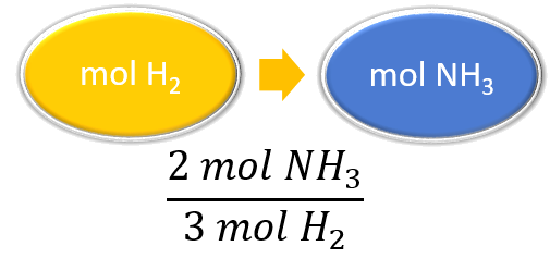 |
| Cancel units and calculate. |
\(\cancel{4.20 \: \text{mol} \: H_2} \times \dfrac{2 \: \text{mol} \: NH_3}{\cancel{3 \: \text{mol} \: H_2}} = 2.80 \: \text{mol} \: NH_3\) The reaction of \(4.20 \: \text{mol}\) of hydrogen with excess nitrogen produces \(2.80 \: \text{mol}\) of ammonia |
| Think about your result. | The result corresponds to the 3:2 ratio of hydrogen to ammonia from the balanced equation. |
- Given the following balanced chemical equation,\[\ce{C5H12 + 8O2 → 5CO2 + 6H2O} \nonumber \]how many moles of H2O can be formed if 0.0652 mol of C5H12 were to react?
- Balance the following unbalanced equation and determine how many moles of H2O are produced when 1.65 mol of NH3 react.\[\ce{NH3 + O2 → N2 + H2O} \nonumber \]
- Answer a:
- 3.14 mol H2O
- Answer b:
- 4NH3 + 3O2 → 2N2 + 6H2O; 2.48 mol H2O
Mass Relationships in Chemical Equations
It is a small step from mole-mass calculations to mass-mass calculations. If we start with a known mass of one substance in a chemical reaction (instead of a known number of moles), we can calculate the corresponding masses of other substances in the reaction. The first step in this case is to convert the known mass into moles, using the substance’s molar mass as the conversion factor. Then—and only then—we use the balanced chemical equation to construct a conversion factor to convert that quantity to moles of another substance, which in turn can be converted to a corresponding mass. Sequentially, the process is as follows:

This three-part process can be carried out in three discrete steps or combined into a single calculation that contains three conversion factors. The following example illustrates both techniques.
Ammonium nitrate decomposes to dinitrogen monoxide and water according to the following equation.
\[\ce{NH_4NO_3} \left( s \right) \rightarrow \ce{N_2O} \left( g \right) + 2 \ce{H_2O} \left( l \right) \nonumber \]
In a certain experiment, \(45.7 \: \text{g}\) of ammonium nitrate is decomposed. Find the mass of each of the products formed.
| Steps for Problem Solving | Example \(\PageIndex{2}\) |
|---|---|
| Identify the "given"information and what the problem is asking you to "find." |
Given: \(45.7 \: \text{g} \: \ce{NH_4NO_3}\) Mass \(\ce{N_2O} = ? \: \text{g}\) Mass \(\ce{H_2O} = ? \: \text{g}\) |
| List other known quantities |
1 mol \(\ce{NH_4NO_3} = 80.06 \: \text{g/mol}\) 1 mol \(\ce{N_2O} = 44.02 \: \text{g/mol}\) 1 mol \(\ce{H_2O} = 18.02 \: \text{g/mol}\) 1 mol NH4NO3 to 1 mol N2O to 2 mol H2O |
| Prepare two concept maps and use the proper conversion factor. |
|
| Cancel units and calculate. |
\(45.7 \: \text{g} \: \ce{NH_4NO_3} \times \dfrac{1 \: \text{mol} \: \ce{NH_4NO_3}}{80.06 \: \text{g} \: \ce{NH_4NO_3}} \times \dfrac{1 \: \text{mol} \: \ce{N_2O}}{1 \: \text{mol} \: \ce{NH_4NO_3}} \times \dfrac{44.02 \: \text{g} \: \ce{N_2O}}{1 \: \text{mol} \: \ce{N_2O}} = 25.1 \: \text{g} \: \ce{N_2O}\) \(45.7 \: \text{g} \: \ce{NH_4NO_3} \times \dfrac{1 \: \text{mol} \: \ce{NH_4NO_3}}{80.06 \: \text{g} \: \ce{NH_4NO_3}} \times \dfrac{2 \: \ce{H_2O}}{1 \: \text{mol} \: \ce{NH_4NO_3}} \times \dfrac{18.02 \: \text{g} \: \ce{H_2O}}{1 \: \text{mol} \: \ce{H_2O}} = 20.6 \: \text{g} \: \ce{H_2O}\) |
| Think about your result. | The total mass of the two products is equal to the mass of ammonium nitrate which decomposed, demonstrating the law of conservation of mass. Each answer has three significant figures. |
Methane can react with elemental chlorine to make carbon tetrachloride (\(\ce{CCl_4}\)). The balanced chemical equation is as follows.
\[\ce{CH4 (g) + 4 Cl2 (g) → CCl2 (l) + 4 HCl (l) } \nonumber \]
How many grams of HCl are produced by the reaction of 100.0g of \(\ce{CH4}\)?
- Answer
- 908.7g HCl
Summary
- Calculations involving conversions between moles of a substance and the mass of that substance are described.
- The balanced chemical reaction can be used to determine molar and mass relationships between substances.
Contributors and Attributions
- TextMap: The Basics of GOB Chemistry (Ball et al.)
Henry Agnew (UC Davis)

